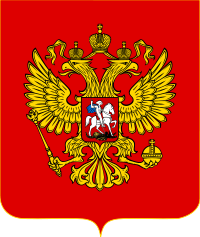Kostroma
| Kostroma (English) Кострома́ (Russian) |
|
|---|---|
| — Inhabited locality — | |
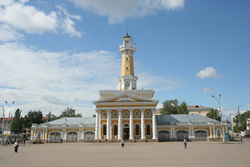 Fire-observation watchtower in Kostroma (1825-1828) |
|
.svg.png) Location of Kostroma Oblast in Russia |
|
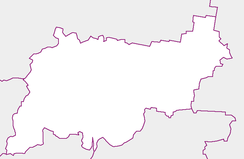 Kostroma
|
|
| Coordinates: | |
 |
|
| Administrative status | |
| Country | Russia |
| Federal subject | Kostroma Oblast |
| Administrative center of | Kostroma Oblast |
| Municipal status | |
| Urban okrug | Kostroma Urban Okrug |
| Mayor | Alexandr Andreyevich Kudryavtsev |
| Representative body | City Duma |
| Statistics | |
| Population (2002 Census) | 278,750 inhabitants[1] |
| - Rank | 68 |
| Time zone | MSK/MSD (UTC+3/+4) |
| Founded | 1152 |
| Postal code(s) | 156XXX |
| Dialing code(s) | +7 +7 4942 |
| [www.gradkostroma.ru Official website] | |
Kostroma (Russian: Кострома́) is an historic city in central Russia, the administrative centre of Kostroma Oblast. A part of the Golden ring of the Russian towns, it is located at the confluence of the Volga and Kostroma Rivers. Population: 278,750 (2002 Census);[1] 278,414 (1989 Census).[2] It is served by Kostroma Airport.
Contents |
Kostroma under the Rurikids
The city was first recorded in the chronicles for the year 1213, but historians believe it could have been founded by Yury Dolgoruky more than half a century earlier. Like other towns of the Eastern Rus, Kostroma was sacked by the Mongols in 1238. It then constituted a small principality, under leadership of Prince Vasily the Drunkard, a younger brother of the famous Alexander Nevsky. Upon inheriting the grand ducal title in 1271, Vasily didn't leave the town for Vladimir, and his descendants ruled Kostroma for another half a century, until the town was bought by Ivan I of Moscow.
As one of the northernmost towns of Muscovy, Kostroma served for grand dukes as a place of retreat when enemies besieged Moscow in 1382, 1408, and 1433. In 1375, the town was looted by Novgorod pirates ("ushkuiniki"). The spectacular growth of the city in the 16th century may be attributed to the establishment of trade connections with English and Dutch merchants (Muscovy Company) through the northern port of Archangel. Boris Godunov had the Ipatievsky and Epiphany monasteries rebuilt in stone. The construction works were finished just in time for the city to witness some of the most dramatic events of the Time of Troubles.
Kostroma was twice ravaged by the Poles; it took a 6-month siege to expel them from the Ipatievsky monastery. The heroic peasant Ivan Susanin became a symbol of the city's resistance to foreign invaders; several monuments to him may be seen in Kostroma. The future tsar, Michael Romanov, also lived at the monastery. It was here that an embassy from Moscow offered him the Russian crown in 1612.
Kostroma under the Romanovs
It is understandable why the Romanov tsars regarded Kostroma as their special protectorate. The Ipatievsky monastery was visited by many of them, including Nicholas II, the last Russian tsar. The monastery had been founded in the early 14th century by a Tatar prince, ancestor of the Godunov family. The Romanov tsars had the magnificent Trinity Cathedral rebuilt in 1652; its frescoes and iconostasis are a thing of beauty. A wooden house of Mikhail Romanov is still preserved in the monastery. There are also several old wooden structures transported to the monastery walls from distant districts of the Kostroma Oblast.
Town status was granted in 1719.
In 1773, Kostroma was devastated by a great fire. Afterwards the city was rebuilt with streets radiating from a single focal point near the river. They say that Empress Catherine dropped her fan on the city map, and told the architects to follow her design. One of the best preserved examples of the 18th century town planning, Kostroma retains some elegant structures in a "provincial neoclassical" style. These include a governor's palace, a fire tower, a rotunda on the Volga embankment, and an arcaded central market with a merchant church in the center.
Sights and landmarks
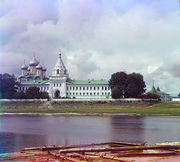
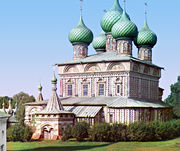
Built in 1559-1565, the five-domed Epiphany Cathedral was the first stone edifice in the city; its medieval frescoes perished during a fire several years ago. The minster houses the city's most precious relic, a 10th-century Byzantine icon called Our Lady of St. Theodore (Russian: Федоровская Богоматерь). It was with this icon that Mikhail Romanov was blessed by his mother when he left for Moscow to claim the Russian throne. They say that just before the Revolution the icon blackened so badly that the image was hardly visible; it was interpreted as a bad sign for the Romanov dynasty.
The Ipatievsky monastery survives mostly intact, with its 16th-century walls, towers, belfry, and the 17th-century cathedral.
Apart from the monasteries, most of the city churches were either rebuilt or demolished during the Soviet years. The only city church that survives from the 17th-century "golden age" is the of gold instead. He resolved that the unearned gold was the devil's gift and decided to spend it on building a church, beautiful within and without. Two other 17th-century temples, of rather conventional architecture, may be seen on the opposite side of the Volga.
Among the vestiges of the Godunov rule, a fine tent-like church in the village Krasnoe-on-the-Volga (formerly an estate of Boris Godunov's brother) may be recommended.
International relations
Twin towns — Sister cities
Kostroma is twinned with:
 Aachen, Germany.
Aachen, Germany.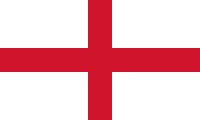 Durham, England.
Durham, England. Durham, North Carolina, United States.
Durham, North Carolina, United States.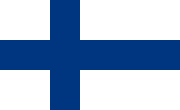 Hyvinkää, Finland.
Hyvinkää, Finland.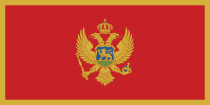 Cetinje, Montenegro.
Cetinje, Montenegro.
External links
- Kostroma
- City map
- Kostroma Vurtual Tour
- http://www.mykostroma.ru/
- (Russian) History and sights of Kostroma
- http://kosinfo.ru Kostroma Info
- (English) Kostroma city beautiful architecture views
References
- ↑ 1.0 1.1 Федеральная служба государственной статистики (Federal State Statistics Service) (2004-05-21). "Численность населения России, субъектов Российской Федерации в составе федеральных округов, районов, городских поселений, сельских населённых пунктов – районных центров и сельских населённых пунктов с населением 3 тысячи и более человек (Population of Russia, its federal districts, federal subjects, districts, urban localities, rural localities—administrative centers, and rural localities with population of over 3,000)" (in Russian). Всероссийская перепись населения 2002 года (All-Russia Population Census of 2002). Federal State Statistics Service. http://perepis2002.ru/ct/html/TOM_01_04_1.htm. Retrieved 2009-08-19.
- ↑ "Всесоюзная перепись населения 1989 г. Численность наличного населения союзных и автономных республик, автономных областей и округов, краёв, областей, районов, городских поселений и сёл-райцентров. (All Union Population Census of 1989. Present population of union and autonomous republics, autonomous oblasts and okrugs, krais, oblasts, districts, urban settlements, and villages serving as district administrative centers.)" (in Russian). Всесоюзная перепись населения 1989 года (All-Union Population Census of 1989). Demoscope Weekly (website of the Institute of Demographics of the State University—Higher School of Economics. 1989. http://demoscope.ru/weekly/ssp/rus89_reg.php. Retrieved 2007-12-13.
|
||||||||||||||||||||||||||||
